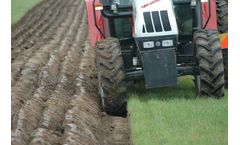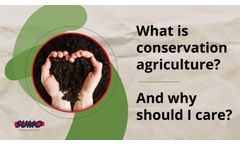Tillage Effects On Soil Articles & Analysis
19 articles found
Soil compaction is becoming a major issue worldwide. Not only in the Netherlands but globally the soil is deteriorating very badly. Soil compaction is a form of soil degradation, in which the soil structure is lost because the soil is compressed. This global problem is still underestimated and causes problems for agriculture, nature, and climate. Furthermore, soil compaction leads to loss of ...
Such methods can lead to savings on labour, fuel, and maintenance. Minimum or zero tillage means soils are cultivated as little as possible which should help farmers to save time and reduce wear and tear on machinery. ...
2020 has been a challenging year with forces so far out of our control, it actually seems the situation has gone from the ridiculous to the absurd. With saturated land, the New Agriculture Bill (the bill) and the Coronavirus pandemic the industry has to look at improving farming practices to stay on track. The main conversation is how farmers cover the ground with less passes, less disturbance ...
The Corps/EPA look to re-regulate PCC while the USDA is concerned about long term wetland effects or impacts that me associated with farming. To try to explain this I have copied the entire PCC discussion text from the memo below. ...
Common factors that affect suggested N rates are timing of application, climate, crop rotation, tillage system and soil productivity. When using too little N, a crop such as corn results in lower yields and reduced profits. ...
In Hungary, the MARGINS project is being conducted near Lake Balaton - the largest lake in Central Europe. The lake is renowned for its beauty and wildlife. Its surrounding hilly landscape is covered with rich brown forest soil. This landscape is, however, prone to soil erosion -in particular, rills develop when soil is weakened by excessive tillage and exposed to intense rainstorms. If not ...
BySyngenta
Such an effect is consistent with a net loss of soil organic C recently observed for the Morrow Plots, America's oldest experiment field, after 40 to 50 yr of synthetic N fertilization that substantially exceeded grain N removal. A similar decline in total soil N is reported herein for the same site and would be expected from the predominantly ...
Tillage systems may influence soil microbial communities and N mineralization enzymes through alterations in total soil C and N. Soil aggregates of different sizes provide diverse microhabitats for microorganisms and therefore influence soil enzyme activities. ...
We evaluated the 21-yr effect of tillage and cropping sequence on dryland grain and biomass (stems + leaves) yields of spring wheat (Triticum aestivum L.), barley (Hordeum vulgare L.), and pea (Pisum sativum L.) and soil organic matter at the 0- to 20-cm depth in eastern Montana, USA. ...
In dry land areas of the Mediterranean region, farmers' decisions are particularly difficult due to irregular rainfall. Yield risk, soil erosion and desertification are important problems. Decision-making behaviour of farmers is supposed to incorporate a particular concern in the adoption of strategies to decrease income variability, to conserve soil and to ...
Compacted soils have been found in intensively cultivated vegetable crop regions of Central Wisconsin, resulting in the wide scale use of subsoil tillage by growers. ...
Continuous no-till (NT) results in soil improvements, primarily in the surface 5 cm of soil. One-time tillage may improve NT systems by inverting surface soil with less improved deeper soil. Research was conducted to determine the change in abundance of soil microbial groups after a one-time tillage of NT and their recovery dynamics. Experiments were conducted under rainfed corn (Zea mays L.) or ...
Little is known about soil redistribution by tillage and its impact on the properties of soil profiles with thin soil layers on hillslopes. In this study, consecutive tillage by hoeing was performed 5 and 15 times on an Orthic Regosol within a steep hillslope landscape of the Sichuan Basin, China, to simulate the impact of short- and long-term tillage on soil profile properties at different slope ...
No tillage often delays soil warming and drying, thus sowing too early in the spring may compromise seed viability due to prolonged exposure to cold and wet soil in the northern Corn Belt. Coating seed with a temperature-activated polymer may circumvent the adverse effects of exposing seeds to cold and wet soil. ...
Tillage systems may affect soil C sequestration, with a potential impact on crop productivity or organic matter mineralization. ...
Yield potential is often constrained by severe water deficits during grain fill which might be alleviated by reducing runoff throughout the season using microbasin or tie-ridge tillage. Research was conducted to determine the effects of time of tie-ridge tillage and planting method on soil water availability and on the ...
A 7-yr study (1977–1982, and 1985) to evaluate tillage and tillage timing effects on soil water storage, crop water use, and grain yield of winter wheat (Triticum aestivum L.) and spring green pea (Pisum sativum L.) in rotation, was conducted near Pendleton, OR. Treatments included (i) fall plow (FP)–fall moldboard plow after ...
Conservation tillage is a commonly adopted best management practice for reducing runoff and erosion, and increasing infiltration. Yet current methodologies in place to monitor conservation tillage adoption are largely inappropriate for regional or national assessments. A major goal of this study was to evaluate the spectral response properties of four alternative winter cover crops using remotely ...
A number of policy tools are used to reduce soil erosion from agricultural lands in the USA, including education and technical assistance, financial assistance, land retirement, and conservation compliance requirements. Education and technical assistance by public and private sources can be effective in promoting the adoption of conservation ...








